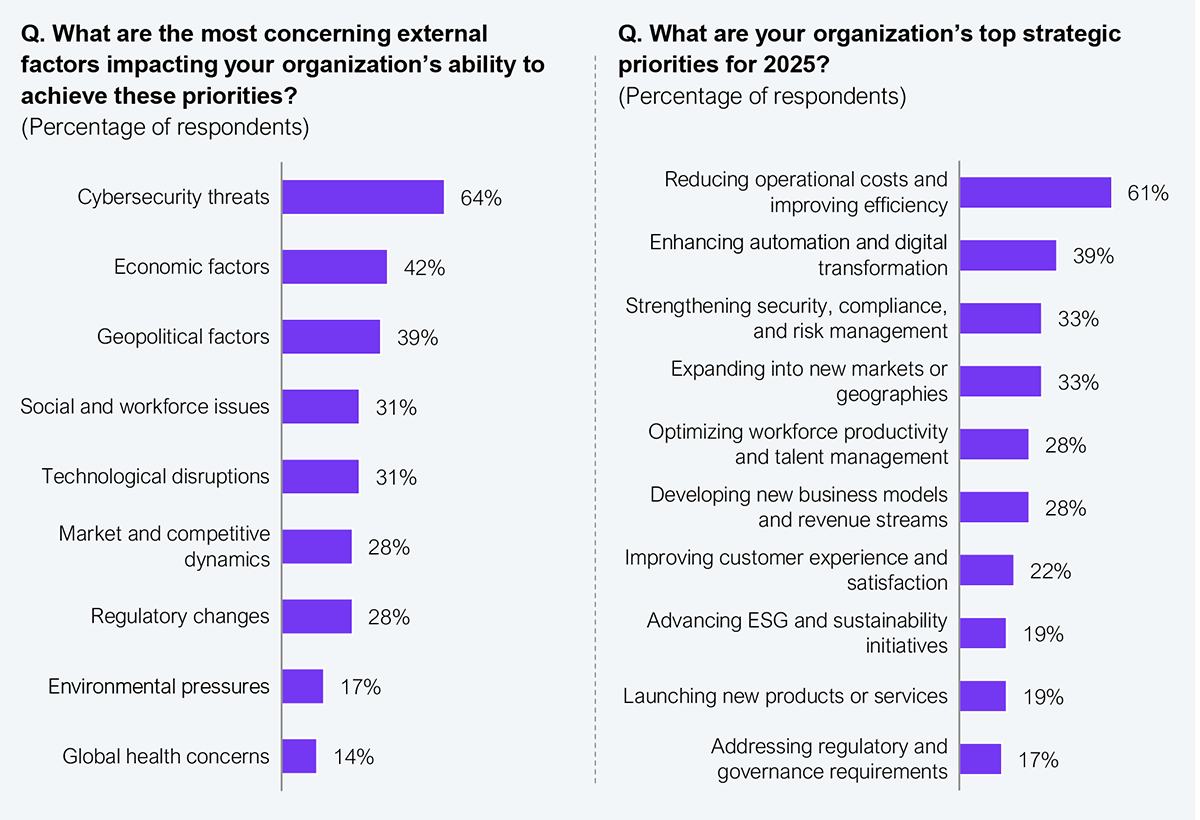Insurers are facing a profitability crisis they can’t tackle alone. Protection gaps are widening, rate-led growth is stalling, and property cover is becoming unaffordable. On top of that, life propositions are fading while climate and cyber risks are escalating at an alarming rate. Internally, the drag is just as severe, with rising costs, aging systems, and a shrinking workforce eroding their ability to respond (see Exhibit 1).
Carriers must break this cost-complexity curve now or risk losing margin, growth, and long-term relevance. The only way forward is to partner with ecosystem players that bring mature digital and domain capabilities to deliver real outcomes at speed and scale.

Source: 36 global insurers
Source: HFS Research, Pulse 2025
Many underwriters still handle tasks that basic automation should have retired years ago. Those low-hanging activities are now table stakes. Catching up isn’t innovation but merely keeping pace. The real leap is applying digital intelligence to high-risk, high-stakes decisions: combining GenAI and intelligent automation so underwriters can embed “digital” into the complex parts of the business.
The same holds for claims. The goal isn’t to automate every interaction, but to know where automation adds value and where human judgment is essential. While straight-through processing already resolves low-severity claims across the industry, the real bottleneck is complex claims that rules and RPA alone can’t handle. Complex claims demand nuanced judgment in customer and stakeholder interactions. Embedding thoughtful digital solutions alongside human expertise at the right touchpoints can absorb much of this complexity without compromising the integrity of critical functions.
In essence, insurance is about accurately understanding risk and supporting people in distress, efficiently and empathetically. AI is reshaping both. Pairing traditional analytical AI (pattern detection in structured data) with GenAI enables the interpretation of unstructured content with real context, personalization, and more empathy. When combined with the cognitive lift of agentic AI to automate complex workflows from start to finish, insurers stand to gain numerous benefits, provided these tech are implemented responsibly. Freshly minted is Xceedance’s Digital Underwriter Assistant, a traceable, auditable, enterprise-grade engine that is already triaging submissions, with compliance bots delivering 100% accuracy on sanctions checks.
Technology, however powerful, doesn’t solve everything. AI systems aren’t deterministic, and human judgment remains essential. We see this in claims, where Xceedance combines digital enablement with its large third-party administrator operations, blending technology and human expertise to deliver efficiency and empathy, ensuring that even the most complex claims are handled with speed, accuracy, and trust. Case in point: its digital–human claims model trimmed five days from the claims cycle and increased new-business efficiency by 30–60%.
Insurers often chase a “sexy” front end to deliver a slick consumer experience. But true modernization only takes place when that front end is wired into a modern agile core, featuring real-time data feeds, AI-driven decisions, and deep ecosystem connectivity.
Modernization starts with shedding legacy—not as an IT project, but as a business transformation. Too many carriers still treat it as a “nuts-and-bolts” tech. Every investment must translate into clear business outcomes, with IT and the business co-owning the agenda; otherwise, you’re just retrofitting old processes onto new systems.
This is Xceedance’s bailiwick: possessing the business-side process acumen and enterprise integration strength across systems, API enablement, and cloud-led modernization. The result: core platforms that are connected with third-party data and adjacent ecosystems to capture AI value, enabling the platforms to evolve and align with the carrier’s innovation goals. The caveat is that while Xceedance brings strong core systems expertise and deep ties with platforms such as Duck Creek, its limited exposure to non-insurance tech providers and cross-industry stacks may restrict flexibility. Insurers must ultimately own the decision while selecting core systems.
Yesterday’s core capabilities won’t win tomorrow. Insurers must apply automation and AI where they compound value and preserve human judgment where it protects trust and margins. Partner with providers to reimagine the insurance business for a more resilient and profitable future. It’s time to stop firefighting and start future-shaping.
Register now for immediate access of HFS' research, data and forward looking trends.
Get StartedIf you don't have an account, Register here |
Register now for immediate access of HFS' research, data and forward looking trends.
Get Started